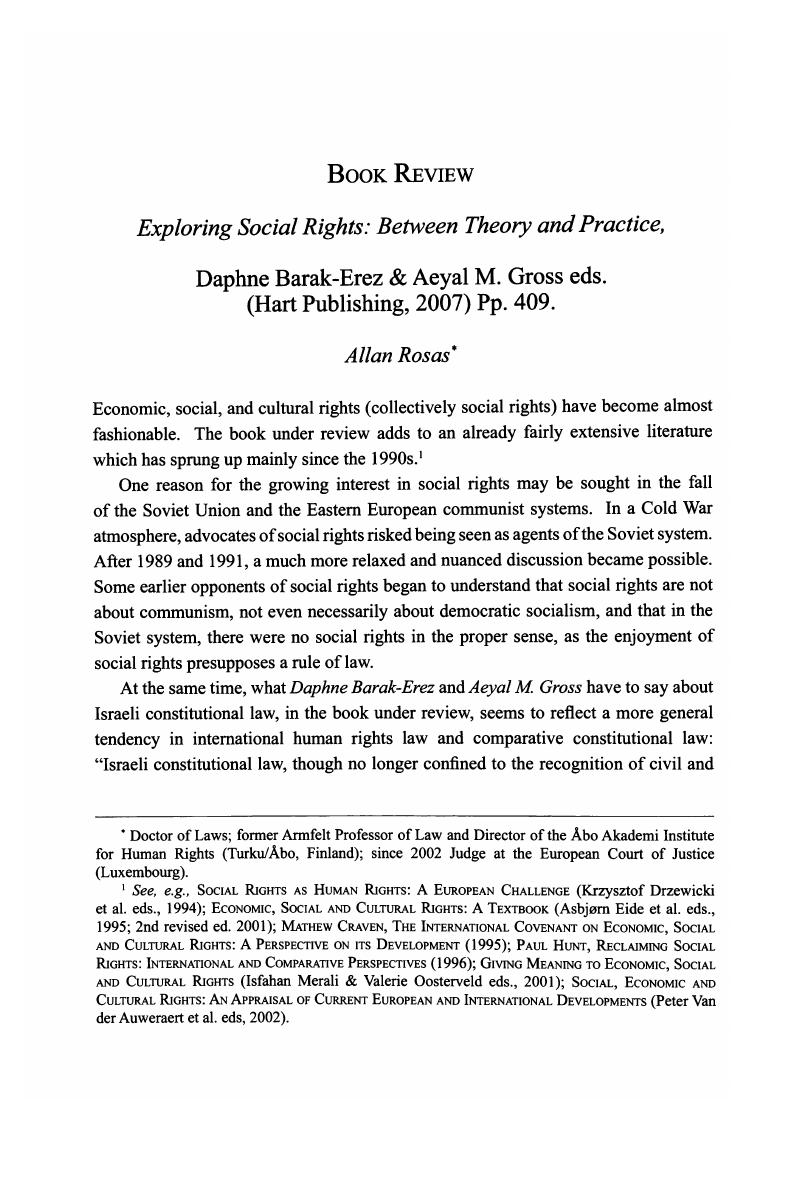Published online by Cambridge University Press: 19 March 2012

1 See, e.g., Social Rights as Human Rights: A European Challenge (Drzewicki, Krzysztof et al. eds., 1994)Google Scholar; Economic, Social and Cultural Rights: A Textbook (Eide, Asbjørn et al. eds., 1995; 2nd revised ed. 2001)Google Scholar; Craven, Mathew, The International Covenant on Economic, Social and Cultural Rights: A Perspective on its Development (1995)Google Scholar; Hunt, Paul, Reclaiming Social Rights: International and Comparative Perspectives (1996)Google Scholar; Giving Meaning to Economic, Social and Cultural Rights (Merali, Isfahan & Oosterveld, Valerie eds., 2001)CrossRefGoogle Scholar; Social, Economic and Cultural Rights: An Appraisal of Current European and International Developments (Van der Auweraert, Peter et al. eds, 2002).Google Scholar
2 Exploring Social Rights: Between Theory and Practice 261 (Barak-Erez, Daphne & Gross, Aeyal M. eds., Oxford 2007)Google Scholar [hereinafter Exploring Social Rights].
3 See, e.g., para. I:5 of the Vienna Declaration and Programme of Action, adopted by consensus by the World Conference on Human Rights on 25 June 1993, U.N. doc. A/CONF.157/23 (July 12, 1993): “All human rights are universal, indivisible and interdependent and interrelated.”
4 Barak-Erez, Daphne & Gross, Aeyal M., Introduction: Do We Need Social Rights? Questions in the Era of Privatisation, Globalisation, and the Diminished Welfare State, in Exploring Social Rights, supra note 2, at 1, 5 & 6Google Scholar.
5 On such a comparative approach see generally The Jurisprudence of Human Rights Law: A Comparative Interpretative Approach (Orlin, Theodore S. et al. eds., 2000)Google Scholar.
6 Gross, Aeyal M., The Right to Health in an Era of Privatisation and Globalisation: National and International Perspectives, in Exploring Social Rights, supra note 2, at 289, 303Google Scholar.
7 See also Eide, Asbjørn, Economic, Social and Cultural Rights as Human Rights, in Economic, Social and Cultural Rights: A Textbook 23–25 (Eide, Asbjørn et al. eds., 2nd revised ed. 2001)Google Scholar.
8 Baxi, Upendra, Failed Decolonisation and the Future of Social Rights: Some Preliminary Reactions, in Exploring Social Rights, supra note 2, at 41, 42 & 46Google Scholar.
9 Id. at 55.
10 See, e.g., Galtung, Johan, Human Rights in Another Key 161 n.5 (1994)Google Scholar.
11 “Everyone is entitled to a social and international order in which the rights and freedoms set forth in this Declaration can be fully realized.” See Eide, Asbjørn, Article 28, in The Universal Declaration of Human Rights: A Common Standard of Achievement 597 (Alfredsson, Gudmundur & Eide, Asbjørn eds., 1999)Google Scholar.
12 See, e.g., Rosas, Allan, The Right to Development, in Economic, Social and Cultural Rights: A Textbook, supra note 7, at 119Google Scholar.
13 White, Lucie, ‘If You Don't Pay You Die’: On Death and Desire in the Post Colony, in Exploring Social Rights, supra note 2, at 57Google Scholar.
14 Id. at 72.
15 See especially Baxi, supra note 8, at 41 and Mundlak, Guy, The Right to Work the Value of Work, in Exploring Social Rights, supra note 2, at 341,356Google Scholar.
16 On the horizontal application of fundamental rights in the case law of the European Court of Justice see Case C-144/04, Werner Mangold v. Rüdiger Helm, 2005 E.C.R. I-9981 (discrimination based on age); Case C-438/05, International Transport Workers' Federation et al. v. Viking Line ABP, 2007 E.C.R I-10779 and Case C-341/05, Laval an Partneri v. Svenska Byggnadsarbetareförbundet et al., 2007 E.C.R. I-11767 (right to collective action v. an economic freedom).
17 See Article 51, paragraph 1, of the Charter proclaimed on Dec. 7, 2000 (2000 O.J. (C 364) 1). The Charter is not legally binding but has become an important “soft law” instrument, see, e.g., Case C-540/03, European Parliament v. Council of the European Union, 2006 E.C.R. I-5769, para. 38. See also Article 52, para. 5, added to the Charter as adapted on Dec. 12, 2007 (2007 O.J. (C 303) 1) as a corollary to the Treaty of Lisbon, signed on Dec. 13, 2007 (2007 O.J. (C 307) l), and the Explanations to the Charter updated in 2007 (id. at 17). Article 6, para. 1, of the Treaty on European Union, as amended by the Treaty of Lisbon (a consolidated version of the Treaty of Lisbon is to be found in 2008 O.J. (C 115) 1), would make the Charter legally binding but at the time of writing, neither the Treaty of Lisbon nor the adapted version of the Charter are in force.